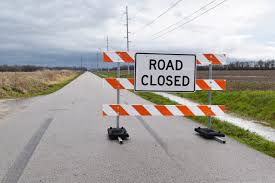By DAVID A. LIEB, MICHAEL CASEY, JEFF MCMURRAY and CHRISTOPHER KELLER Associated Press
After a yearlong closure, a bridge over the Puyallup River reopened in 2019 with a sturdy new span and a brand new name. It even won a national award.
But today, the Fishing Wars Memorial Bridge is closed again after federal officials raised concerns about a vintage section of the nearly century-old bridge that carried about 15,000 vehicles a day. It has no timetable to reopen because the city of Tacoma, Washington, first must raise millions of dollars to clean and inspect it.
“It’s frustrating — and hard to comprehend how we got here,” said Ed Wallace, whose Harley-Davidson motorcycle store has lost customers since the nearby bridge was shuttered.
Bridges fulfill a vital function that often goes overlooked until lives are lost or disrupted by a closure or collapse, like that of the Francis Scott Key Bridge in Baltimore early Tuesday. That bridge crumpled when struck by a cargo ship, not because of poor maintenance. But thousands of others stand in worse shape.
About 42,400 U.S. bridges are in poor condition, yet they carry about 167 million vehicles each day, according to the federal government. Four-fifths of them have problems with the legs holding them up or the arms supporting their load. And more than 15,800 of those bridges also were in poor shape a decade ago, according to an Associated Press analysis.
One of those persistently poor bridges — carrying about 96,000 westbound vehicles daily on Interstate 195 over the Seekonk River in Rhode Island — was suddenly shut to traffic late last year, resulting in long delays as drivers diverted to new routes. In March, the governor announced that the bridge must be demolished and replaced. That could cost up to $300 million and take at least two years to complete.
These closures illustrate a nationwide issue.
“We have not maintained our infrastructure at the rate that we should for many, many years, and now we’re trying to play catch-up,” said Marsia Geldert-Murphey, president of the American Society of Civil Engineers.
When an old bridge gets closed because of safety concerns, it disrupts daily commutes, business supply chains and emergency response times by police, firefighters and medical personnel. Yet many bridges still await replacement or repairs because the costs can reach millions or even billions of dollars.
A FUNDING INFUSION
A massive infrastructure law signed by President Joe Biden in 2021 directed $40 billion to bridges over five years — the largest dedicated bridge investment since construction of the interstate highway system, which began nearly 70 years ago.
Transportation Secretary Pete Buttigieg said that law already is funding over 7,800 bridge projects. One of the most notable is a $3.6 billion project in Cincinnati to build a long-awaited new bridge carrying traffic on Interstates 71 and 75 over the Ohio River at the Kentucky border.
But funding from the infrastructure law will make only a dent in an estimated $319 billion of needed bridge repairs nationwide, according to the American Road & Transportation Builders Association.
“The bottom line is that America’s bridges need a lot of work,” Buttigieg told the AP after visiting the closed Rhode Island bridge. He added: “The sooner we can address those significant bridges, the less likely they will be abruptly taken out of service, or worse, experience the risk of a collapse.”
Inspectors rate bridges using a 0-9 scale, with 7 or above considered “good.” A “poor” rating reflects a 4 or below. A mid-range rating is considered “fair.” The nation’s poor bridges are on average 70 years old.
Even before the federal funding infusion, the number of bridges in poor condition declined 22% over the past decade as structures were repaired, replaced or permanently closed, according to the AP’s analysis. But in recent years, more bridges also slipped from good to fair condition.
COLLAPSING BRIDGES
Though potholes on bridges can jar cars, many of the most concerning problems are below the surface. Chipping concrete and rusting steel can weaken the piers and beams that keep a bridge upright. When the condition of substructures or superstructures deteriorates too much, a bridge typically is closed out of public safety concerns.
Though rare, bad bridges can eventually collapse.
Design flaws contributed to the evening rush hour collapse of an Interstate 35 bridge over the Mississippi River in Minneapolis in 2007. The collapse killed 13 people and injured 145 others. It also was costly financially. A state analysis estimated Minnesota’s economy lost $60 million in 2007-2008 due to increased travel time and operating costs for commuters and businesses.
In January 2022, a bridge carrying a bus and several cars collapsed over Fern Hollow Creek in Pittsburgh, causing injuries but no deaths. Federal investigators determined the steel legs had corroded to the point of having visible holes, yet inspectors failed to calculate the severity of the problem and the city failed to follow repeated recommendations.
“This bridge didn’t collapse just by an act of God. It collapsed because of a lack of maintenance and repair,” National Transportation Safety Board member Michael Graham said.
FINANCIAL CHALLENGES
Iowa has the most poor bridges, followed by Pennsylvania, Illinois and Missouri. The twin Burlington Street bridges in Iowa City, Iowa, exemplify the financial challenges facing old bridges. The state owns the southbound span carrying vehicles over the Iowa River while the city owns the northbound span of what’s also known as state Highway 1.
The city’s part, constructed in 1915, was rated in poor condition in the 2023 and 2013 National Bridge Inventory. Inspection reports show numerous cracks and structural deficiencies in the concrete bridge. The state’s side, built in 1968, is in much better condition.
Although the federal infrastructure law provided a grant to analyze the bridges, the split ownership has made it difficult to fund the more than $30 million estimated cost of a replacement.
“It’s not something we can just fund in a year and say: ‘Here we go, let’s do it quick,’” said city engineer Jason Havel. “It takes years of planning, years of working through dedicated funding.”
ECONOMIC EFFECTS
In Rhode Island, problems had been mounting for the I-195 Washington Bridge connecting Providence to East Providence. It closed after an engineer in December noticed the failure of multiple steel tie rods in concrete beams at two piers. A subsequent examination found widespread structural problems.
Joseph McHugh, an engineer with 40 years of experience in bridge and road construction, reviewed a draft engineering report compiled after the bridge’s closure along with inspection reports from July 2022 and July 2023.
“This failure didn’t occur overnight,” McHugh told the AP. “To me, it should have been caught by an inspection, not by a contractor or whomever was looking at what was going on.”
The U.S. Department of Justice is investigating allegations that false payment claims for the bridge’s construction, inspection or repair were submitted to the federal government.
Marco Pacheco, who owns a liquor store along a main road in a Portuguese neighborhood of East Providence, said he believes “mismanagement,” “negligence” and “incompetence” caused the closure. His business revenue is down 20% since the bridge closed. But he’s even more concerned about the long-term consequences.
“That traffic doesn’t instantly come back. Folks have reshaped their patterns, their thought processes and so on,” Pacheco said.
Business owners in Washington share similar concerns about the indefinite closure of the Fishing Wars Memorial Bridge, in an industrial area near the Port of Tacoma. Several years ago, the city spent $42 million to replace a span leading up to the river. But the bridge was abruptly closed again last October after the Federal Highway Administration raised concerns that debris had prevented the inspection of potentially corroded steel connection points.
To clean and inspect the bridge, the city first must encapsulate it to protect debris from falling into the river. But the city lacks the more than $6 million needed for the project. It also has no means of paying for a potential $280 million replacement.
A nearby Interstate 5 bridge provides a good alternative but that means many motorists zoom right past an exit ramp without thinking about the Harley-Davidson store or other nearby businesses. At least one shop already has closed.
Wallace, the Harley-Davidson store owner, wishes the city could re-open the bridge, at least temporarily.
“Is there a peril that exists?” Wallace asks rhetorically. “Yeah, absolutely, a very serious one for me as a business owner.”







